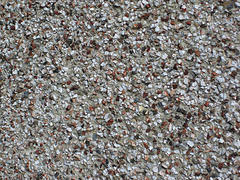External Walls, Painters & Decorators
Preparing and Repairing the outside walls
Rendered walls have a layer of cement-sand mix mortar on top of the structural brick or blocks, rather as interior walls have a layer of plaster. Except in rare cases where they have already been painted with gloss paint ( when you will be able to clean down and put on another coat of paint ) they are usually decorated with a cement based paint, a paint containing sand to give texture or with emulsion paint, which is cheap and holds well to masonry surfaces even out doors.
The Painter & Decorator, before starting work must tie back any wall plants and wrap them in plastic sheets. The floor must be protected in dust sheets too, don’t use plastic sheets as it can become slippery and dangerous. Scrape off any lose or flaking paint.
Small cracks in rendering can be repaired like internal plaster cracks, except that the filler must be one prepared specially for outdoors use.Larger areas of rendering that have failed should be hacked out until a firm edge is reached and then primed with a PVA & water mix for a good key and seal the dust. Then filled with a not-too-wet mixture of one part masonry cement to five parts soft sand. This put on with a steel float. If the rendering is much more than half an inch thick, do it in two coats, scoring the first one as it dries to provide a key for the second.
If the rendering is textured try to match this with the edge of the float or a brush. Pebbledash is rendering sometimes pre-mixed with small stones, but more usually applied flat and having small stones flung against it from a shovel and pressed in with a float.Examine it careful if you want a good match.

Brush down walls to get rid of dust and apply masonry sealer if the surface is powdery. Repaired cracks and other bare areas should be given and undercoat of emulsion paint. A surface which has never been coated before should be wetted a square yard at a time before painting. If it has been painted but is very absorbent thin the first coat by 10 % or so.
The second coat of paint, ( you will need two or more coats of paint )should be put on full strength. Where possible, don’t let an edge dry before paint the adjoining section.
If you require a free quote for painting & decorating your property in London, contact us.
